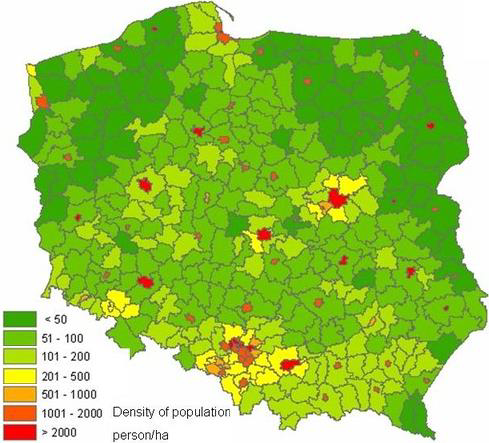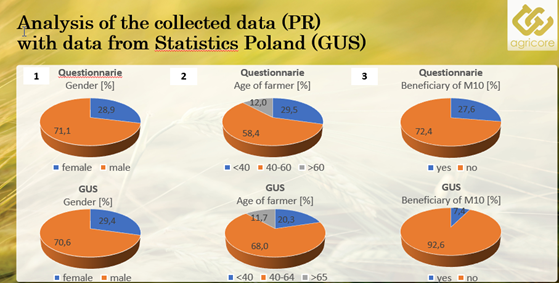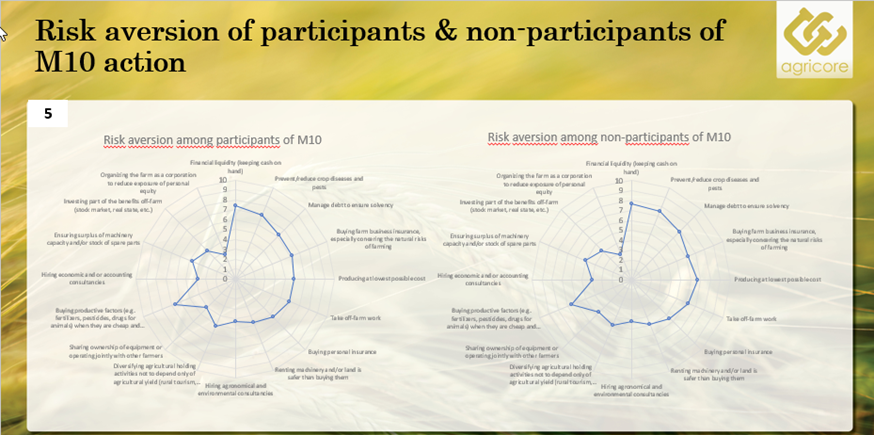Current situation

Poland covers six NUTS level 1 Regions (PL1-PL6) and has a population of 38.43 million of which 39% live in rural areas. All Poland administrative regions are considered as less developed regions under article 2014/99/EU definition. In addition, the country is one of the member states eligible for funding from the Cohesion Fund pursuant to Article 4. Approximately 30% of the total surface of the country (312,696 km2) is covered by forest and 46% is used for agriculture from which 74.7% is arable land and 22.4% is permanent grassland and meadows. About 14,405,650 ha are used for agriculture, with an average area per farm of 10.65 ha (as there are 1,410,700 farms). The sector employs 2,385,500 people. A significant percentage (62.5%) of the agricultural land is classified as areas with natural constraints (ANC – Article 31 of Regulation (EU) 1303/2013). Moreover, 19.4% of the arable land faces various environmental challenges: 8.2% is particularly endangered by water and/or wind erosion, 3.6% experiences problems with low humus levels and 7.4% are defined as Nitrate Vulnerable Zones (areas that drain into waters polluted by nitrates).
The selected instrument for this case study is “M10.1: Agri-environment-climate commitments”, which is included in the national programme (2014PL06RDNP001) for the period 2014-2020 and rooted in the Article 28 of the 1305/2013 EAFRD regulation. The measure contemplates payments to farmers and land-managers who, on a voluntary basis, commit their farming activities to one or more specific agri-environment-climate practice. The analysis will focus on the actions linked to the maintenance and improvement of the biodiversity and to the preservation of natural resources (soil erosion and water quality).
Improvement potential
This AGRICORE use case will analyse the M10.1 measure influence on Poland, especially focusing on the rise of ecosystem services and on the environmental and climate impacts. The ex-post analysis will be done for the period 2014 to 2018 and the ex-ante impact analysis will be done for the period 2019-2020. To perform such analyses, the partners will use FADN, FSS, Eurostat, the Central Statistical Office of Poland, the agency for Restructuring and Modernisation of Agriculture (ARMA) and CAPRI (models/data) databases. The available data will be complemented with information available at the national and regional level and by the execution of participatory research actions. Biophysical models including crop yields models based on precipitation and temperature data, rainfall distribution models and pedotransfer functions will be used for properly calculating the impact of the measure as well as for enhancing the accuracy of the ABM simulations.
A brief overview of the Polish use case (UC 2)
The Polish agricultural area amounts to almost 16 million hectares, which is approximately half of Poland’s territory, with 90% of them standing in good agricultural condition. The Polish agricultural sector consists of almost one million and a half farms, with an average area of 10 hectares. Only half a million hectares are under organic farming. Nearly 62.5% of the Polish agricultural land is classified as areas with natural constraints and slightly more than 10% of Poland´s greenhouse gas emissions come from the agricultural sector. Moreover, almost 20% of arable land faces environmental challenges, most of them related to water and/or wind erosion and nitrate pollution. Almost half of the livestock units are cattle, and the other half is divided mainly between pigs and poultry. There are also 2.4 million workers on farms. In the rural areas, where the farms are located, the distribution of the population’s age is 15% people over 64 years old and 16.4% people under 15 years old.
The M10 action, being part of the EU and national strategic legal frameworks, deals with promoting practices contributing to sustainable land management and protecting landscape diversity, valuable natural habitats, and endangered species of birds. In the M10 “Agri-environment-climate commitments” two sub-measures can be distinguished and the Polish Use Case study is focused mostly on analyzing the effects of sub-measure 10.1 “Payments for Agri-Environment-Climate Commitments”. Up to 2020, nearly 430 thousand applications were submitted to the sub-measure. The total amount of subsidies paid to farmers was equal to 1,085 million EUR. It is shown in Table 1 that the subsidies the farmers could obtain range from ~100 EUR/ha up to ~500 EUR/ha after fulfilling commitments specific to each of the 5 packages.
The support under the measure may be used (Agri-Environmental Action Guide 2016) by a farmer conducting agricultural production in natural areas, i.e., non-agricultural land, on which there are certain types of natural habitats or bird nesting habitats. So far, six application campaigns have been carried out by the end of 2019 (RDP PL 2014-2020): from March 15 to July 10, 2015 (Campaign 2015), from March 15 to July 11, 2016 (Campaign 2016), from March 15 to June 26, 2017 (Campaign 2017), from March 15 to July 10, 2018 (Campaign 2018), from March 15 to June 25, 2019 (Campaign 2019), and in 2020. The number of farms being beneficiaries of the M10 action compared to the entire population of farms in Poland, on average (according to ARMA and FADN), is 99,891, which is about 14% of the total number of market farms (746,000), and 7,01 % of all farms in Poland (~ 1.4 million).
The AGRICORE Polish use case analyses the M10.1 measure influence on Poland, especially focusing on the enhancement of the ecosystem services and on the environmental and climate impacts. The ex-post analysis is planned for the period between 2014 and 2017 and the ex-ante impact analysis will be done for the period 2018-2020. To perform such analyses, the data from the Central Statistical Office of Poland, the agency for Restructuring and Modernisation of Agriculture (ARMA), and some secondary data from relevant publications will be used. The available data will be supplemented with the information available at the national and regional levels and by the execution of participatory research actions.
Summary of activities
The ex-post analysis of this use case has been marked by participatory research consisting of two fundamental elements. On the one hand, all the information was gathered from all possible and available European, national, and regional databases. On the other hand, the questionnaires addressed directly to farmers, the main objective of which was to be able to set all the information which are important for establishing a framework of the analyzed scenarios, and was not available in the databases, were developed and implemented.
The aim was to obtain all the information gaps through a survey campaign with information directly related to the project interest. The missing information gaps are based on the following points:
- Risk aversion
- Innovativeness willingness
- Age, gender, education of decision-makers responsible for strategic decisions
- The legal form of entity
- Risk aversion of decision-makers
- Total number of employees
- Previous experiences of farmers resulting from participation in M10 action
- Type of the main production
- Size of farms
- The minimum size of plots
- Revenues obtained from agriculture that guarantee farmer’s families’ maintenance
- Ecosystem components existing on the farm being friendly for M10 action participation
- Size of parcels
- Location of a farm in relation to Nature 2000 areas
- Size of arable land area
- Special areas existing on the farm
- The profitability of participation in the M10 action
- Social/cultural impact being a barrier/chance to access M10 action
- Bureaucratic/institutional factors being barrier/chance to access M10 action
The development of this activity is defined and described in D1.8 of the AGRICORE project. The design and development of the participatory research aimed to select a representative sample of the Polish farms’ population to be surveyed.
Analysis of charts no. 1 and 2 shows distribution of gender and age, (within sample of PR and population of farms in Poland) and indicate their high compatibility and similar representativeness of the data collected during PR. In case of farmers’ age one can see some differences although in some intervals they are not so essential, older and middle-aged farmers predominate.
Chart no. 3 shows that distributions of beneficiary and not beneficiary of M.10 action within the sample and total population of farmers in Poland are essentially different. One can think that it can be explained by a fact, that respondents are more opened for new challenges including a share within such survey like AGRICORE, so they are also more open for participation in M10 action.
Charts no. 4 and 5 show a rather high risk aversion of Polish farmers although minimization costs of production are not so important for M10 action beneficiaries like for those being not beneficiaries of this action. No significant differences regarding risk aversion were spotted between beneficiaries of M10 action and these, who did not participate in this action, although beneficiaries of M10 action were a bit more open for innovations.


